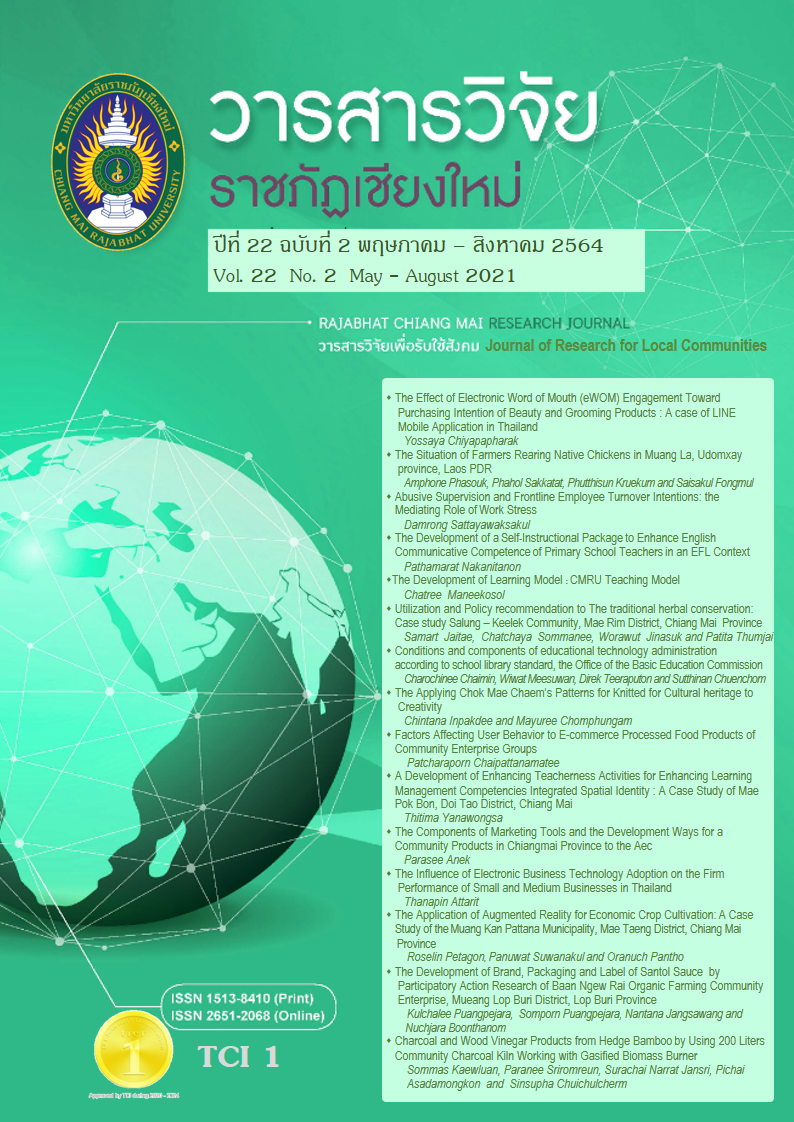The Development of Learning Model : CMRU Teaching Model
DOI:
https://doi.org/10.14456/rcmrj.2021.245638Keywords:
Learning management model, CMRU teaching modelAbstract
The purposes of this research were to 1) Develop the learning model : CMRU Teaching Model 2) Study the effectiveness of learning model : CMRU Teaching Model and 3) Study opinions toward learning model : CMRU Teaching Model. The samples consisted of 10 Prathom Suksa 1-6 teachers and 315 Prathom Suksa 1-6 students in Demonstration School Chiang Mai Rajabhat University, academic year 2019, who were selected by specific selection.The instruments used in this research were 1) lesson plan according to the learning model : CMRU Teaching Model and 2) interview form. Data were analyzed by evaluating the E1/E2 efficiency and content analysis.
The results of the research showed that; 1) Learning model : the developed CMRU Teaching Model has 3 steps which are 1.1) CM: Creative Motivation is the process of creating interest or the creation of internal motivation 1.2) R: Raising Learning’s Capacity is a step to improve the competency of learners. Which is a process of learning activities and 1.3) U: Utilizing Learned Knowledge is the application of understanding knowledge to facing new problem situations. 2) The efficiency of the model (E1/E2) equal to 82.79/81.88, which was higher than the specified criterion. 3) The opinions of teachers on the learning model : CMRU Teaching Model, it was a systematic model, clear procedure for organizing learning activities. It can be used to develop students’ knowledge, understanding, work skills, thinking skills and characteristics of being a good leader and follower. And students’ opinions were, it’s fun to learn, actual actions in various activities, both in individual and group work. They also have a chance to comment, courageous and have the opportunity to think creatively design in their own work.
Downloads
References
Anderson, T.P. (1997). “Using Models of Instruction”. In C.R. Dills and A.J. Romis Zowski (eds.), Instructional Development Paradigms. Englewood Cliffs, New Jersey: Education Technology Publications.
Chueabangkaew, M. (2013). Development of a learning management model that promotes critical thinking skills Advanced scientific processes and scientific attitudes. (Doctoral dissertation, Burapha University). (In Thai).
Eggen, P.D., & Kauchak, D.P. (2006). Strategies and Models for Teachers Teaching Content and Thinking Skills. (5thed.). Boston: Pearson Education, Inc.
Eisner, E. (1976). Education Connoisseurship and Criticism : Their Form and Functions in Educational Evaluation. Journal of Aesthetic Education, 10(3), 192-193.
Independent Committee for Educational Reform. (n.d.), Thai education reform Report of the Independent Committee for Educational Reform. n.p.
Jamornman, U. (1998). What is a model ?. Academic journal, 1(3), 22-25. . (In Thai).
Joyce, B., & Weil, M. (1996). Models of Teaching. (5th ed.). New York: Allyn & Bacon.
Joyce, B., & Weil, M.. (2000). Models of Teaching. (6thed.). Massachusetts: Allyn & Bacon.
Kaewkhamsai, S. (2002). Role of school administrators in student-centered teaching. Elementary school Under the Office of Primary Education, Roi Et. (Master Thesis, Srinakharinwirot University). (In Thai).
Keeves, J. P. (1998). Education Research, Methodology and Measurement. A International Handbook. New York: Pergamon.
Khaemmanee, T. (2007). Pedagogy: Knowledge for organizing the learning process. (2nded.). Bangkok: Chulalongkorn University Press. (In Thai)
Khaemmanee, T. (2012). Teaching Science: Knowledge for effective learning process. (15thed.). Bangkok: Chulalongkorn University. (In Thai)
Khamasorn, N. (1988). The comparison of educational philosophical concepts among administrators’ private secondary school in Bangkok. (Master of Education Thesis, Chulalongkorn University).
Kimanuwat, N. (2016). Development of teaching models to develop systematic thinking processes for secondary school students. (Doctoral dissertation, Burapha University). (In Thai)
Ministry of Education. (2003). The National Education Act, B.E. 2542, Amendment (No. 2), B.E. 2545. Bangkok: Teachers' Council.
Office of the High School Administration, Office of the Basic Education Commission. (n.d.). Guidelines for learning management in the 21st century: 21st Century Skills. n.p.
Panich, V. (2012). A way to create learning for students in the 21st century. Bangkok: Sodsri-Saritwong Foundation.
Phuwipadawat, S. (2001). Student-centered seizure and real assessment. 4th ed.. Chiang Mai: Light Art Printing House.
Sathorn, P. (1982). Educational administration. Bangkok: S.M. Printing.
Sorndej, P. (2010). Development of teaching models to practice mathematical thinking skills for primary school students. (Doctoral dissertation, Burapha University). (In Thai)
Thumthong, B. (2010). Development of a learning management model to develop a systematic thinking process in mathematics. Level 4. (Doctoral dissertation, Khon Kaen University). (In Thai)
Wasi, P. (1999). Intellectual process. Bangkok: Sodsri-Saritwong Foundation and the Office of the National Education Commission.
Yamkasikorn, M. (2003). Development of Teaching Models for Systematic Thinking Development of Undergraduate Students. (Doctoral dissertation, Srinakharinwirot University). (In Thai).
Downloads
Published
How to Cite
Issue
Section
License
1. Articles, information, content, images, etc published in the “Community and Social Development Journal” are copyrighted by the Community and Social Development Journal, Chiang Mai Rajabhat University. In order to properly distribute the articles through print and electronic media, the authors still hold the copyright for the published articles under the Creative Commons Attribution (CC BY) license, which allows the re-distribution of the articles in other sources. References must be made to the articles in the journal. The authors are responsible for requesting permission to reproduce copyrighted content from other sources.
2. The content of the articles appearing in the journal is the direct responsibility of the article authors. The editorial board of the journal does not necessarily agree with or share any responsibility.














